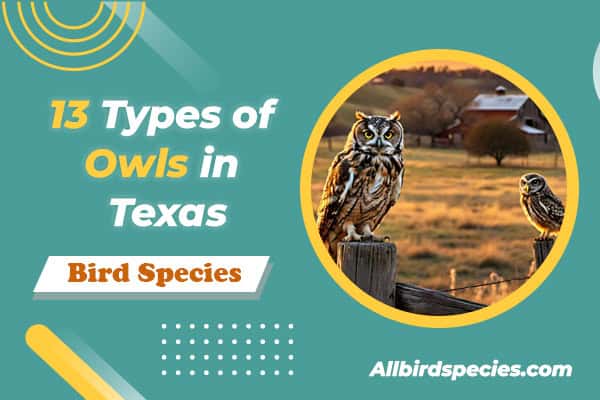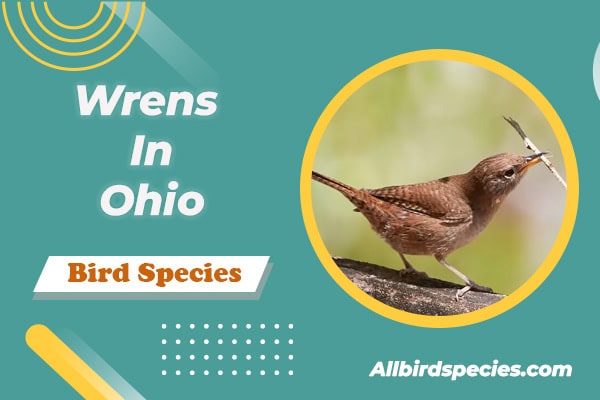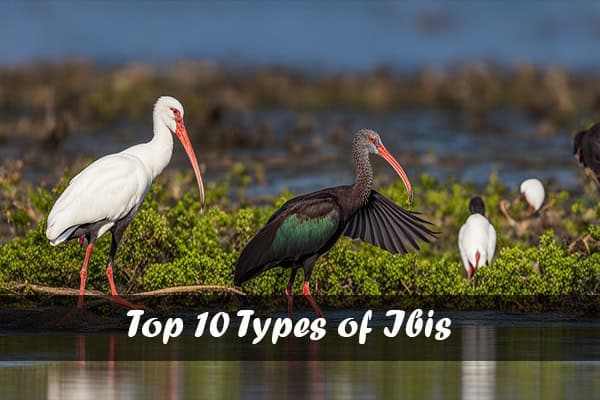Spotting Owls in Texas (13 Species With Photos)
I’ve researched the state’s rich birdlife, including owls in Texas, a group that captivates many. With a bird list boasting 670 species, Texas’s diverse habitats are a birdwatcher’s paradise. Owls here, with their keen senses, thrive in the night, hunting with precision. No matter your location, you’re never far from a prime birding spot, from Buffalo Lake in the northwest to the coastal refuges. Of the 17 owl species recorded, 13 are native, each with its unique haunts across this vast state.
Here we’ll learn about 13 different types of Owls in Texas!!
1. Short-eared Owl
- Scientific name:Asio flammeus
- Lifespan:4 years (average), 12 years (maximum recorded)
- Size:13.4 to 16.9 in
- Weight:7.3 to 16.8 oz
- Wingspan:33.5 to 40.5 in
- Status: Least concern
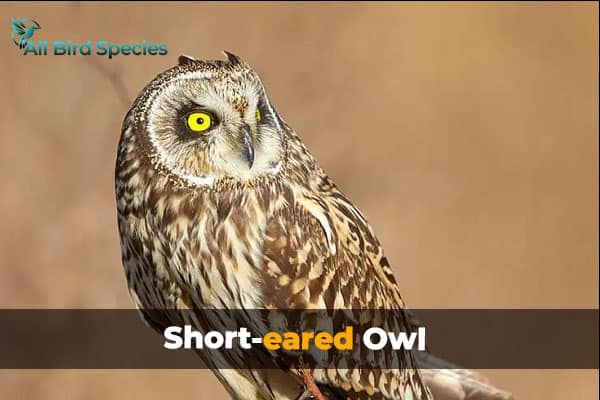
The Short-eared Owl is a cool bird with tiny ear tufts. It’s mostly white and tan with some dark spots, and it has a white face with yellow eyes.
Firstly, you won’t hear them much in Texas, but they do hoot when they’re looking for a mate. Secondly, they build their nests on the ground, hidden in the grass. They make a simple nest and line it with soft feathers.
Next, the female owl lays up to 11 eggs, and she sits on them for about three weeks to a month. The baby owls stay in the nest for a couple of weeks before they’re ready to fly.
Moreover, these owls of Texas eat lots of small animals, like mice and voles. They’re pretty good at hunting, especially at night.
Lastly, there are enough Short-eared Owls out there, so they’re not in danger right now. But we have to be careful because their homes are getting destroyed, which could make it hard for them to survive.
2. Great Horned Owl
- Scientific name:Bubo virginianus
- Lifespan:13 years (average), 28 years (maximum recorded)
- Size:18.1 to 24.8 in
- Weight:32.1 to 88.2 oz
- Wingspan:39.8 to 57.1 in
- Status: Least concern
the Great Horned Owl, Texas’s largest owl. These majestic birds sport significant ear tufts and a grey-brown appearance, complete with a grey or red-brown facial disk. Their throats are snowy white, and their underwings are pale.
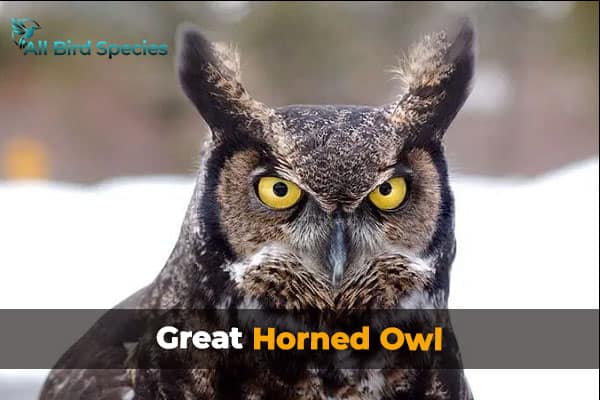
Now, here’s where it gets interesting: Great Horned Owls are quite the vocal bunch. Imagine a series of hoots echoing through the night—hoo-hoo-hoo-hoo—that’s them!
When it comes to nesting, they’re not exactly DIY enthusiasts. Instead, they’re squatters, taking over old stick nests built by other bird species—hawks, crows, herons, or ravens. Occasionally, they’ll nest in tree holes, cliff ledges, platforms, or even abandoned buildings. Their nests are cozy, lined with downy feathers, leaves, and bark.
As for family planning, female Great Horned Owls lay one to four eggs per clutch. After a patient wait of 30 to 37 days, the chicks hatch. And when they’re ready to stretch their wings, they leave the nest after about 42 days.
Now, let’s talk menu. These owls of Texas are top-tier predators, dining on a diverse buffet. They’re not picky—they’ll even snack on birds heavier than themselves! Their favorite prey includes mammals like hares, mice, and rabbits, as well as waterfowl, corvids, doves, and pigeons. Occasionally, they’ll nibble on insects, reptiles, fish, and even carrion. Talk about a varied diet!
But wait, there’s more: Great Horned Owls are adaptable survivors. Their population of approximately 5.7 million breeding birds remains stable, thanks to their ability to thrive in changing environments. However, they face threats from illegal hunting and pesticide exposure due to their prey’s poisoned meals.
So next time you’re out and about in Texas—whether in swamps, orchards, woodlands, or agricultural areas—keep an eye out for these remarkable residents. They’re the wise guardians of the night, silently watching over their diverse habitats.
3. Barred Owl
- Scientific name – Strix varia
- Lifespan – 8 years (average), 26 years (maximum recorded)
- Size – 16.9 to 19.7 in
- Weight – 16.6 to 37 oz
- Wingspan – 39 to 43.3 in
- Status – Least concern
The Barred Owl, a large bird with dark eyes and a yellow beak, is known for its unique call that sounds like “Who cooks for you?” With a patterned underside and brown-barred wings and tail, they’re a sight to behold.
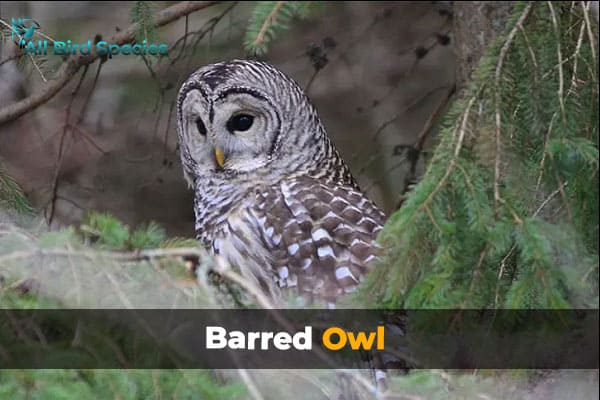
These owls don’t build their nests; instead, they use old nests or tree cavities, adding a personal touch with lichen and feathers. They lay 1-5 eggs, which take about a month to hatch, and the young are ready to fly in just over a month. Their diet is diverse, ranging from small mammals to birds and even fish. With a stable population of 3.5 million, they’re not currently at risk, but their habitats are threatened by logging, even as they expand their range due to forest management and tree planting in the plains.
4. Eastern Screech Owl
- Scientific name – Megascops asio
- Lifespan – 4 years (average)
- Size – 6.3 to 9.8 in
- Weight – 4.3 to 8.6 oz
- Wingspan – 18.9 to 24 in
- Status – Least concern
The Eastern Screech Owl is a small, chubby-looking owl with tiny feathers on its head that look like ears. They are mostly grey with patterns of dark lines and thicker, darker streaks. They have light-colored faces, yellow eyes, and usually dark beaks. But in southern Texas, their beaks might be lighter.

Also, there’s a red version of this owl. It looks a lot like the grey one, but it’s red and has darker lines and a row of white feathers on its belly.
These owls make a sound that’s like a horse’s whinny.
Now, these owls like to live in old holes in trees made by squirrels or woodpeckers. They’re also okay with living in boxes made for them. They don’t put anything soft in their nests.
The mother owl lays between two and six eggs at a time. She keeps them warm for about 27 to 34 days until they hatch. The baby owls then stay in the nest for another 26 to 30 days before they’re ready to leave.
Eastern Screech Owls eat lots of small animals and birds. They hunt for mice, rats, moles, squirrels, rabbits, and even some small birds like swallows, finches, and doves. They also eat frogs, lizards, crayfish, worms, and bugs.
Although these owls are not in immediate danger of disappearing, their numbers have gone down by 37% in the last 50 years. There are about 560,000 of them that can have babies.
They’re losing their homes because of changes in the land, but they’re good at living in cities because they can eat different things and find various places to nest.
5. Burrowing Owl
- Scientific name – Athene cunicularia
- Lifespan – 6 years (average)
- Size – 7.5 to 9.8 in
- Weight – 4.9 to 8.5 oz
- Wingspan – 20.1 to 24 in
- Status – Least concern
The Burrowing Owl is a small owl that stands out because it doesn’t have the feather tufts on its head that look like ears, and it has longer legs. This owl’s back is dark brown with light brown or sandy-colored spots. The chest looks similar to the back, but the stomach area is a creamy color with dark, straight lines across it. They have brown heads, white throats, yellow eyes, white marks above their eyes, and yellow beaks.
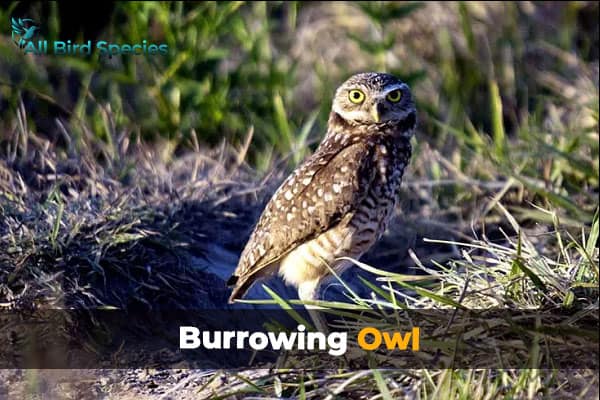
These owls don’t make a lot of noise, but when they do, it sounds like a soft cooing that has two different tones.
True to their name, Burrowing Owls live in holes in the ground. They usually move into burrows made by other animals like prairie dogs, badgers, and tortoises.
Inside their burrows, they might put things like animal manure, grass, feathers, or other materials to make it cozy. Sometimes, they even dig the burrows themselves.
When it comes to laying eggs, they can have anywhere from two to twelve in one go. The eggs stay warm for about 28 to 30 days before they hatch. After hatching, the young owls stay in the nest for about 44 to 53 days before they’re ready to venture out.
6. Barn Owl
- Scientific name – Tyto alba
- Lifespan – 4 years (average)
- Size – 12.6 to 15.8 in
- Weight – 14.1 to 24.7 oz
- Wingspan – 39.4 to 49.2 in
- Status – Least concern
Barn Owls are a kind of owl that’s not too big or too small. They don’t have the tufts of feathers on their heads that some owls have. The bottom part of their body is mostly white, and the top part is a mix of light brown and grey. They have a white face that looks like a heart and their eyes are dark.

Instead of the usual hoot, they make a scratchy, loud noise.
Barn Owls are not fussy about where they live. They make their homes in holes in trees, cracks in cliffs, underground burrows, caves, old buildings, and even boxes made just for them. They create their nests by coughing up pellets and shaping them into a bowl.
They can lay a lot of eggs, anywhere from two to eighteen at a time. These eggs take about 29 to 34 days to hatch, and the baby owls stay in the nest for quite a while, around 50 to 55 days.
They mostly eat small animals like rats, voles, lemmings, mice, shrews, rabbits, and bats. Sometimes, they also eat birds like blackbirds, meadowlarks, and starlings.
7. Western Screech Owl
- Scientific name – Megascops kennicottii
- Lifespan – 8 years (average)
- Size – 7.5 to 9.8 in
- Weight – 3.5 to 10.8 oz
- Wingspan – 21.6 to 24.4 in
- Status – Least concern

The Western Screech Owl, known for its distinctive call and small stature, is an interesting species with unique nesting habits and a varied diet. Here’s a brief overview of the key points about this owl:
- Appearance: Small with tiny ear tufts, available in brownish-red and grey morphs. In Texas, only the grey morph is observed. Features include a pale face with a dark outline, yellow eyes, and dark streaking on a paler underside.
- Call: A series of whistled hoots that accelerate, similar to a bouncing ping-pong ball.
- Nesting: Prefers cavities, often using abandoned woodpecker nests or naturally formed tree cavities. Can also use nest boxes in wooded areas.
- Reproduction: Lays 2-7 eggs per clutch, incubated for 26-34 days. Nestlings stay in the nest for about 35 days.
- Diet: Eats small mammals, birds, fish, amphibians, crustaceans, and various invertebrates.
- Conservation: Classified as a species of low concern, with an estimated 180,000 breeding individuals, though there may have been a decline over the past fifty years.
They play a role in their ecosystem by controlling the population of small mammals and insects. Despite being of low conservation concern, it’s important to monitor their population to ensure it remains stable.
8. Ferruginous Pygmy Owl
The Ferruginous Pygmy Owl is a tiny owl without any ear tufts. Its feathers are a mix of rusty brown and grey-brown, and it doesn’t have any patterns on its back. Behind its head, two dark spots look like fake eyes.

On its face, there are two white lines above its yellow eyes, kind of like eyebrows. The owl’s belly is mostly white but has some brown lines.
It’s known for making loud whistling sounds.
Where it lives: These little owls of Texas likes to live in old holes in trees or big cacti. These holes are often left by woodpeckers or just form naturally over time.
Eggs and Babies: It usually lays about three to five eggs at a time. The eggs need 28 days to hatch. Once the baby owls are born, they leave the nest after 27 to 30 days.
What it eats: It eats lots of bugs, like caterpillars, crickets, and beetles. It also eats small birds, scorpions, tiny animals, and lizards.
9. Flammulated Owl
The Flammulated Owl is a small owl that can be reddish or grey. It has dark eyes and tiny ear tufts. Its belly is light with dark lines and some rusty spots. The rest of its body is grey, brown, or a bit red.
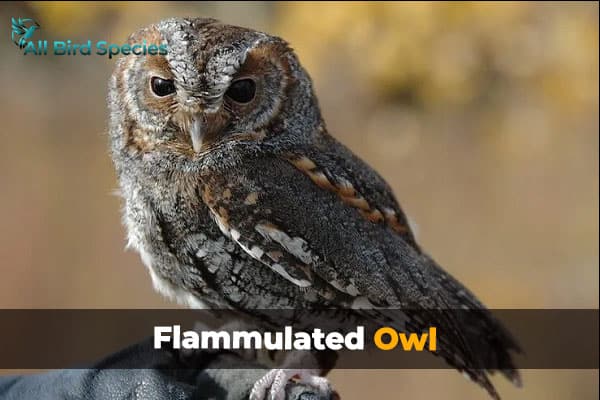
The owl gets its name because it has a pattern that looks like flames. Also, it has an orange stripe on the sides of its body.
Flammulated Owl This owl makes a deep hooting sound.
It lives in holes in trees, often in ones left by woodpeckers or natural holes. Sometimes, they use boxes made for nesting.
The mother owl lays two to three eggs. The baby owls hatch in about three weeks, and they leave the nest in about 25 days.
They mostly eat insects like moths, grasshoppers, crickets, beetles, and other small bugs. Once in a while, they might eat bats, mice, little shrews, and birds.
Check Our Previous Articles:
10. Elf Owl
The Elf Owl is one of the smallest birds of prey in the world.
Their tiny bodies are grey or rufous (reddish-brown) and do not have ear tufts. They have a brown face with yellow eyes and white markings above their eyes that look like eyebrows.

The top of their bodies is covered in grey, rusty, white, and brown spots. The feathers on their shoulders have white tips that form white stripes on each side of their body. The underside of the Elf Owl has brownish-grey streaks and white patches.
Their call sounds like a puppy yapping, with a series of sounds that get lower in pitch as the call goes on.
The Elf Owls of Texas usually nest in holes in trees or cacti that woodpeckers have made. Sometimes, they nest in nest boxes.
11. Northern Saw-whet Owl
The Northern Saw-whet Owl is a tiny owl with no ear tufts. It has a light brown and white mottled belly, and its head is light brown with white lines. Between its yellow eyes, there’s a clear white V shape.
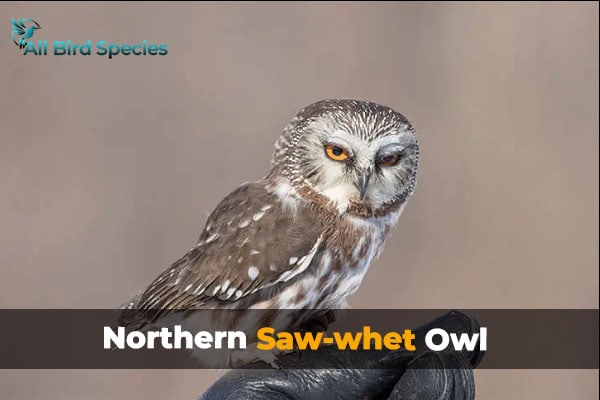
This owl makes a loud “too-too-too” sound.
They live in tree holes made by woodpeckers or in special boxes made for them.
Female owls lay 4 to 7 eggs. They sit on the eggs for 26 to 29 days to keep them warm. After the baby owls hatch, they stay in the nest for 27 to 34 days.
They mostly eat small animals like mice, shrews, voles, bats, baby squirrels, gophers, and chipmunks.
They can also eat small birds like kinglets, chickadees, sparrows, warblers, waxwings, and robins. They might eat insects like grasshoppers and moths too.
There are about 2 million Northern Saw-whet Owls. They are not in danger right now.
12. Long-eared Owl
The Long-eared Owl is a medium-sized bird known for its distinctive long ear tufts. Here are some key characteristics and behaviors:

- Appearance: They have pale buff underparts with dark streaking and a greyish-brown upper side with buff, brown, and black patches. The face is orange with two white lines between the yellow eyes.
- Vocalization: Typically quiet, they occasionally emit a whoo call.
- Nesting Habits: Prefers to nest in old stick nests made by other species like magpies, ravens, crows, and hawks. They may also nest in tree and cliff holes or squirrel nests, though this is rare.
13. Spotted Owl
The Spotted Owl is a medium-sized owl without ear tufts.
They are mostly brown with white spots on their chest, belly, head, and upper parts. Their faces are dark brown with white patches forming an X between their brown eyes.
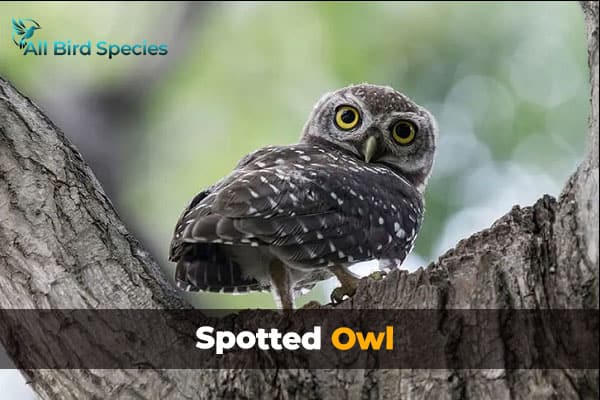
The Spotted Owl’s most common call is a series of hooting sounds.
They nest in various places like broken-off tree tops, hollows in tree trunks, old squirrels and raptor nests, or clumps of mistletoe. In Texas and Mexico, they sometimes nest on canyon walls and ledges. Occasionally, they use human-made nesting holes. When building their own nest, they scrape a hole in the nesting site and line it with feathers.
Female Spotted Owls lay one to four eggs in each clutch. The chicks hatch after 28 to 32 days, and they learn to fly after 34 to 36 days.
Frequently Asked Questions
Q1: Are owls common in Texas?
Yes, owls are quite common in Texas, with several species found throughout the state.
Q2: What is the largest owl in Texas?
The largest owl in Texas is the Great Horned Owl.
Q3: Where to see owls in Texas?
You can see owls in various habitats across Texas, including forests, grasslands, and urban areas. Popular spots include Big Bend National Park, the Hill Country, and the Rio Grande Valley.
Q4: What kind of owls live in Houston, Texas?
In Houston, you can find several owl species, including the Great Horned Owl, Eastern Screech-Owl, Barred Owl, and Barn Owl.

